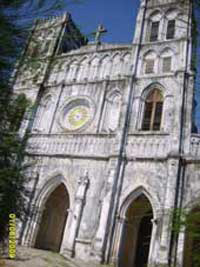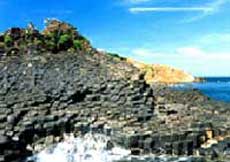About 600km from HCM City and 1,200km from Ha Noi, the central province of Phu Yen is widely recognised by drivers as the third way point on the highway that connects the two largest cities of the country.
|

Saintly home: Mang Lang Church, the oldest church in Phu Yen Province and a shrine to Catholics, dazzles in the sunlight.
|
Dubbed "the land between two mountain passes", Phu Yen is one of the most geographically isolated provinces of the country, bordering Cu Mong Pass to the north and Ca Pass to the south, both of which skirt the coast, affording breathtaking mountain-and-sea views.
According to historians, in 1611, Lords of Nguyen, who ruled the south during the feudal partition of the country, established the Phu Yen Prefecture then built a frontier outpost to mark the territory as part of the southern drive.
So, while the province is looking forward to its fourth centenary, it’s worth a trip to explore early marks of Vietnamese people’s exploration during a time of historic upheaval and westerners’ arrival.
Mang Lang Church
Thirty kilometres to the north of Tuy Hoa City, the provincial capital, where Ngan Son Bridge crosses Ky Lo River, turn right to go off-the-beaten track to Mang Lang Church in An Ninh Tay Commune, Tuy An District.
The church is the oldest remaining in the province, where Christianity started to take hold 400 years ago.
The dirt-track runs through central villages and green rice paddy fields. Sights of kids riding buffaloes, haystacks and young boys splashing in the river are a reminder of less hurried times.
Situated at the heart of a village, the brick church stands around 15m tall with two parallel square bell towers.
Time has left its own marks on the church’s façade with the lime paint flaking here and there, revealing stark brown patches.
The church shines when sunlight reflects off the white lime walls.
Given that it looks to the south-west, the best time in the day to appreciate it is early afternoon when the façade reacts fully with sunlight.
Elements of East and West meet with French architecture bearing typically Vietnamese patterns.
"It was built in 1892 by French priest Joseph de la Cassagne and modeled after the Notre Dame de Paris," says priest Nguyen Cap, who is in charge of the parish, noting that it has not changed much since then.
However, the church has as much significance as substance, and people are drawn here not only to admire its beauty but also to learn about stories of two great figures who left marks in Christian and cultural histories of the country.
They are Andrew Phu Yen, the first Vietnamese martyr who was beatified by Pope John Paul II in 2000 and who is in the process of canonisation, and Alexandre de Rhodes, a French missionary who invented chu Quoc ngu, or the Romanised Vietnamese script.
Rhodes arrived in Phu Yen around 1641, according to priest Nguyen Cap, and baptised around 90 locals, including Andrew Phu Yen, whose real name is unknown.
Andrew Phu Yen became a catechist two years later, using Rhodes’ hand-written Cathechismus (Catechism), the very first document written in chu Quoc ngu, and he was martyred in 1644 at the age of 19.
An artificial lawn hill in front of the church hides within its belly a shrine built in 2006 in dedication to the martyr and serves as a chapel for pilgrims.
The temple leads guests through chronologies of the two figures with pictures and objects, including a painting drawn in 1652 describing the execution of Andrew Phu Yen, some of his hairs taken from Rome, where his remains are kept, and copies of Cathechismus and Vietnamese-Latin-Portuguese Dictionary by Alexandre de Rhodes.
"We received pilgrims all year round, especially from May to September," says priest Nguyen Cap, pointing to a new building behind the church to accommodate pilgrims.
They usually pray to a 2-metre bronze statue of the martyr in men’s long dress standing solemnly in the church yard which is the prototype of a smaller gilded statue offered to Pope Benedict XVI, Cap says.
 Da Dia Rock Cliff (Ghenh Da Dia)
Da Dia Rock Cliff (Ghenh Da Dia)
Ten kilometres on from Mang Lang Church, at An Ninh Dong Commune, is considered as one of the most beautiful stepping-stone rock beaches in the country.
A camping ground is on top of the cliff. Campers can sleep in the middle of nowhere, under the star-studded sky listening to the ocean.
Naturally formed stone steps lead you down to the base of the cliff where a stone reef like a giant honey comb runs out to the sea.
The cliff is like myriad rocks leaning on one another in a strange symmetry as if someone took pains to arrange them.
These ebony and brown rocks range from 10 to 50cm in diametre, and are hexagon, square, round or rectangular in shape. Guests should watch their steps because some rocks have been worn slippery smooth by the ocean.
According to scientists, Da Dia Rock Cliff was formed by flowing lava from volcanic eruptions which solidified when it reached the sea, cracking vertically into columns.
The tracks leading to the church and the cliff are really bumpy, but a new road under construction from Tuy Hoa will facilitate accesses, given that the beautiful beach is attracting attention from investors.
Some other tourist sites are recommended for tourists when visit Phu Yen such as: Cham Tower, Da Trang Pagoda, Xuan Dai Bay – which is being proposed as one of the world’s most beautiful bays, Vung Ro, Long Thuy Beach, Mui Dien Lighthouse and so on.
Phu Yen is getting ready for activities of the 400th founding anniversary of the province (1611 – 2011) and the national tourism year. To prepare National Tourism Year 2011 in Central and Southern coastal provinces and Phu Yen, a plan for promotion from now to 2011 is being established, including advertisements on Phu Yen’s tourist sites.
Phu Yen - untouched destination is waiting for your discovery.
How to get there:
+ Tuy Hoa City is one of main stops of North-South Express trains and on National Highway No.1A.
+ There are four to five flights a week from Ho Chi Minh City to Tuy Hoa and vice versa.
From October 24th, 2009, Vietnam Airlines will operate direct flight linking Ha Noi and Tuy Hoa and vice versa with three flights a week on Monday, Wednesday, and Saturday.
Depart from Ha Noi at 7h30 and arrive Tuy Hoa at 9h10; vice versa depart from Tuy Hoa at 9h55 and arrive Ha Noi at 11h35.
During the opening period from now to October 30, 2009, Vietnam Airlines offers promotional fare of VND705,000 for one-way ticket of this route.
Phuong Anh (Edited)